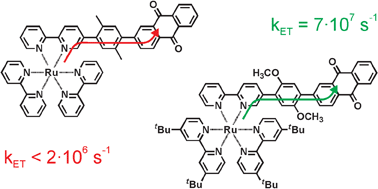Photoinduced electron transfer in covalent ruthenium–anthraquinone dyads: relative importance of driving-force, solvent polarity, and donor–bridge energy gap†
Abstract
Four rigid rod-like molecules comprised of a Ru(bpy)32+ (

* Corresponding authors
a
Georg-August-Universität Göttingen, Institut für Anorganische Chemie, Tammannstrasse 4, D-37077 Göttingen, Germany
E-mail:
oliver.wenger@chemie.uni-goettingen.de
Fax: +49 (0)551 39 3373
Tel: +49 (0)551 39 19424
Four rigid rod-like molecules comprised of a Ru(bpy)32+ (

 Please wait while we load your content...
Something went wrong. Try again?
Please wait while we load your content...
Something went wrong. Try again?
J. Hankache and O. S. Wenger, Phys. Chem. Chem. Phys., 2012, 14, 2685 DOI: 10.1039/C2CP23240E
To request permission to reproduce material from this article, please go to the Copyright Clearance Center request page.
If you are an author contributing to an RSC publication, you do not need to request permission provided correct acknowledgement is given.
If you are the author of this article, you do not need to request permission to reproduce figures and diagrams provided correct acknowledgement is given. If you want to reproduce the whole article in a third-party publication (excluding your thesis/dissertation for which permission is not required) please go to the Copyright Clearance Center request page.
Read more about how to correctly acknowledge RSC content.
 Fetching data from CrossRef.
Fetching data from CrossRef.
This may take some time to load.
Loading related content
